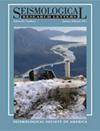节点和宽带地震仪补充帝国谷暗光纤DAS阵列
IF 3.2
3区 地球科学
Q2 GEOCHEMISTRY & GEOPHYSICS
引用次数: 0
摘要
分布式声传感(DAS)技术提供了有效获取密集连续地震数据的能力,这些数据来自预先存在的、未使用的埋在地下的光缆(暗光纤),这些光缆最初是为电信而部署的。然而,这些光纤装置通常沿着公路和铁路轨道使用现有的“路权走廊”,导致分段线性或准线性地震接收器几何形状,从而降低了它们在大范围地震研究中的效用。短期和密集的地震仪阵列可以用来补充暗光纤DAS阵列,从而提高DAS阵列附近更广泛区域的地震接收器覆盖范围。本研究描述了在南加州帝国谷27公里长的暗光纤DAS阵列附近运行的三个临时宽带地震站和69个节点地震仪的同步和互补网络的部署策略和程序、数据和元数据。研究区是一个地震活动性强、断陷性强的张拉构造沉积盆地,区内有多处产地热田。宽带站采用直埋式传感器,转角周期为120s,从2021年9月至2022年9月连续运行一年。从2022年2月到3月,5hz三分量节点地震仪在~ 37 km × ~ 24 km的区域内获得了大约一个月的连续数据,平均站间距为~ 3 km。宽带和节点站都记录了大量的环境地震噪声和高质量的当地地震数据,这些数据可用于各种地震学分析,包括当地地震探测和定位,以及体波和面波断层扫描。本文章由计算机程序翻译,如有差异,请以英文原文为准。
Nodal and Broadband Seismometer Complement to the Imperial Valley Dark Fiber DAS Array
Abstract Distributed acoustic sensing (DAS) technology provides the capability to efficiently acquire dense and continuous seismic data on preexisting, unused fiber-optic cables buried in the ground (dark fiber) that were originally deployed for telecommunication. However, these fiber installations typically use existing “right-of-way corridors” along roadways and railway tracks, leading to piecewise linear or quasi-linear seismic receiver geometries, thereby reducing their utility in seismic studies over a broad areal extent. Short-term and dense arrays of seismometers can be deployed to complement dark fiber DAS arrays, leading to improved seismic receiver coverage over a broader area in the vicinity of the DAS array. This study describes the deployment strategies and procedures, data, and metadata of a contemporaneous and complementary network of three temporary broadband seismic stations and 69 nodal seismometers operated in the vicinity of a 27 km long segment of dark fiber DAS array in the Imperial Valley, Southern California. The study area is a sedimentary basin characterized by intense seismicity and faulting in a transtensional tectonic regime, and hosts multiple producing geothermal fields. The broadband stations used direct-burial sensors with a corner period of 120 s and operated continuously for a year from September 2021 to September 2022. The 5 Hz three-component nodal seismometers acquired continuous data for a month approximately from February to March 2022 over a ∼37 km × ∼24 km area, with an average interstation spacing of ∼3 km. Both the broadband and the nodal stations recorded a wealth of ambient seismic noise and high-quality local earthquake data that can be used in a variety of seismological analyses, including local earthquake detection and location, and body-wave and surface-wave tomography.
求助全文
通过发布文献求助,成功后即可免费获取论文全文。
去求助
来源期刊

Seismological Research Letters
地学-地球化学与地球物理
CiteScore
6.60
自引率
12.10%
发文量
239
审稿时长
3 months
期刊介绍:
Information not localized
 求助内容:
求助内容: 应助结果提醒方式:
应助结果提醒方式:


